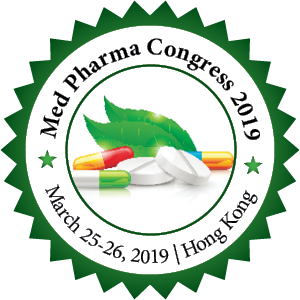
Karina Grzanka
Poznan University of Medical Sciences, Poland
Title: The system of tolfenamic acid with cyclodextrins and their identification
Biography
Biography: Karina Grzanka
Abstract
Introduction & Objective: Tolfenamic acid is a Non-Steroidal Anti-Inflammatory Drug (NSAID) with antipyretic, analgesic and anti-inflammatory effects. Its action is mainly based on the inhibition of COX-1 and COX-2. It is effecative in treating the pain associated with the acute attack of migraines in adults. The drug is absorbed slowly by oral administration. The oral absorption is delayed and it gives a mean lag-time to absorption of 32 minutes. Tolfenamic acid is slightly soluble in water, buffer pH=6.8 and 0.1 M hydrochloric acid
Method: To increase the solubility, tolfenamic acid was connected with magnesium stearate in a ratio of 1:1. An alkaline environment was created that allowed the tolfenamic acid to be dissolved in the buffer pH=6.8. Inclusion cyclodextrin systems (methyl-β-cyclodextrin and 2-hydroxypropyl-β-cyclodextrin) were prepared in solid phase using co-precipitation method. Technique involves stirring together equimolar methanol solution of mixture of tolfenamic acid and magnesium stearate and water cyclodextrin solution. Identification of cyclodextrin tolfenamic acid complex was based on changes FT-IR (Fourier Transform-Infrared Spectroscopy), XRPD (X-ray Powder Diffraction) and DSC (Differential Scanning Calorimetry). The system of tolfenamic acid and cyclodextrin was dissolved in a buffer pH=6.8 imitating the digestive environment in intestines. The studies of apparent solubility were conducted by using Paddle Drug Dissolution Apparatus.
Results: Apparent solubility study showed that tolfenamic acid in system with methyl-β-CD after 190 minutes was solvated in 86%, while system with 2-hydroxypropylo-beta-cyclodextrin after 190 minutes was solvated in 91%. The tolfenamic acid in free form was dissolved in 62.5%. The results were evaluated significantly.
Conclusion: These studies showed that the combination of the tolfenamic acid with cyclodextrin alters its dissolution rate. The tolfenamic acid-cyclodextrin systems showed better solubility in compared to the free form. The type of cyclodextrin used to obtain the tolfenamic acid was a significant importance.
The studies were supported by Ministry of Science and Higher Education from project “ Best of The Best 3.0”

